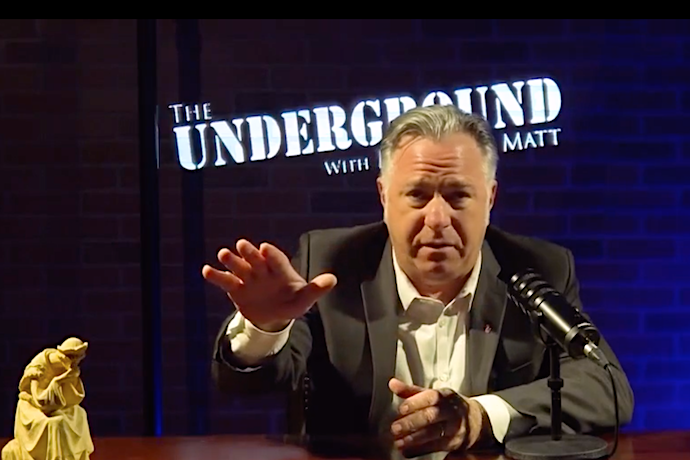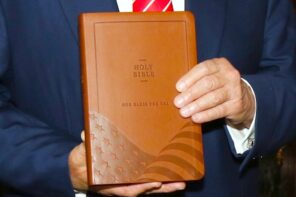On Halloween, Rhode Island police announced that they had arrested Father James Jackson, the pastor of the Priestly Fraternity of St. Peter (FSSP)’s church of St Mary in Providence, Rhode Island, for possession and transfer of child pornography. The response thus far has been interesting—the FSSP released a statement saying they were shocked and saddened and fully cooperating with law enforcement. Some parishioners insisted he was innocent and that he might have been framed; not solely because they love their priest, but because of an ongoing conflict within the church between traditionalists and the modern post-Vatican II liturgy.
Pope Francis’s July Traditionis Custodes was seen as a direct assault against anti-Vatican II traditionalism, which has been characterized by scholar Massimo Faggioli as “[a] problem [that] is particularly acute in the United States, where liturgical traditionalism is a misguided response to a crisis of liturgy more than to a crisis of faith.” The arrest was also seen in this light by the editor of The Remnant, a newspaper by and for radical traditionalists, or “rad trads,” who are engaged in active opposition to the modern Church.
An editorial on the arrest warns:
“We ask our readers to pray for Father Jackson, whether he’s found innocent or guilty. It is abundantly obvious that the forces of hell are keenly intent on corrupting good and holy priests at this pivotal moment in history. We are witnessing the Devil’s final battle, and it should surprise no one when he targets our priests first.”
This language of apocalyptic struggle is common in rad trad spaces, including the Church Militant and The Remnant.
A year ago, writing for Vanity Fair, journalist Kathryn Joyce* pointed out the ways Trumpism has infected the American Catholic Church—Bannon’s brand of militant authoritarianism; rad trad ultraconservatism blending political and theological concerns; and conservative bishops’ opposition to Biden and the Democratic Party. And she pointed out that QAnon has started making inroads in American Catholicism.
A year later, those trends are getting worse–the far right infiltration of the American Catholic Church is now giving way to a growing number of “Q-atholics.” PRRI’s March poll on QAnon’s influence in religious groups has been widely discussed, mostly with regard to evangelical Protestants, but 16% of Hispanic Catholics and 11% of white Catholics agreed with the core QAnon idea that the world is being run by a secret group of Satan-worshipping pedophiles running a global sex-trafficking operation. This still represents a substantial minority of believers subscribing to QAnon doctrines, especially as American rad trads, and overwhelmingly The Remnant, move ever more “Q-atholic.” As the church engages in a quiet schism, the schismatics are only getting more and more apocalyptic.
As Los Angeles Bishop Robert Barron has pointed out, rad trads have used their media platforms to “ruthlessly criticize the pope and bishops, and question the authority of the Second Vatican Council, often to the point of repudiation.” These groups have been prominent in the far right and are part of a much longer tradition of opposition to Vatican II reforms that included the excommunication of Archbishop Marcel Lefebvre by Pope John Paul II in 1988. The Remnant, especially, engages in Covid conspiracies, attacks Pope Francis relentlessly, attacks Vatican II, and pushes respect for former apostolic nuncio to the US Archbishop Carlo Maria Viganò over the pope.
In 2018 Viganò called on Pope Francis to resign, claiming that he tolerated a known sexual abuser and, of course, he attacked Vatican II along the way. In the lead-up to the 2020 election, his actions grew progressively more extreme, including:
- sending an open letter to Trump with QAnon themes in October 2020 that received more Catholic support than expected;
- appearing via video feed at the December 12th 2020 “Let the Church Roar Prayer Rally,” a Jericho March-organized event;
- giving speeches on the “Great Reset” conspiracy in May 2021;
- giving an apocalyptic speech on “Man’s War with God” for a conference in Venice in July, 2021;
- a condemnation of Traditiones Custodes also in July;
- a video message for “No Fear Day,” an anti-Covid restriction event in Turin, entitled “Warning on the Coming Globalist Dictatorship.”
These are QAnon-linked conspiracies, something Viganò uses frequently. Not only does The Remnant promote him repeatedly, but bishops like Athanasius Schneider of Kazakhstan and Joseph Strickland of Tully, Texas (prominent for his support of Jim Caviezel’s QAnon speech last month) support him.
This kind of behavior, an effectively open ideological war within the Church against the Pope, may feel quite foreign now, but it has happened before—repeatedly. A short history lesson may serve as a warning for those tempted to close their eyes and hope this latest far-right uprising goes away. In the Middle Ages, for example, internal battles spread from discussions of theology to full blown anti-papal apocalypticism—a debate over apostolic poverty in the 14th century ended with schismatics calling Pope John XXII the Antichrist, openly declaring that the pope himself was a heretic, and calling in the Holy Roman Empire to intervene.
That kind of language can be heard once again, not only in The Remnant, where Pope Francis has been called a tool of Satan, among other insults; but also from the popular conservative Catholic YouTuber and traditionalist Taylor Marshall (who was appointed to the Trump reelection campaign’s Catholic Advisory Board); from former President Donald Trump; and, of course, from Archbishop Viganó.
While the Middle Ages may feel very distant, the amping up of apocalyptic rhetoric in a struggle over the papacy and the direction of the church is very current—and hoping a consensus can be found will no more serve Pope Francis than hoping that radicalization will remain an internal Catholic issue will work for the rest of us. In other words, waiting around for harmony is likely to harm everyone—even non-Catholics.
John XXII’s conflict with these heretics lasted from the start of his papacy until four years before his death—thirteen years of fighting in both theology and open battle. While one can hope Francis won’t be plagued by QAnon-affiliated radical traditionalists that long, the Catholic far-right in the United States is growing. Figures like Viganò, while influential, are very visibly fringe, as are The Remnant and other so-called “rad trads,” but they all represent fertile ground for QAnon’s influence to continue to grow.
More worrisome, though, is the way that American culture wars spread into conservative Catholic circles and drive them into the arms of QAnon rhetoric. Archbishop José H. Gomez concluded his recent controversial, anti-“woke” speech by warning, “we are seeing signs of an authentic religious awakening going on in America, underneath all the controversy of our politics, the continued clouds of the pandemic, all the uncertainty about where our country is heading.”
That “authentic religious awakening,” in the context of a right-wing grievance-laden talk? One can only hope it will be something other than the awakening of more Qatholics.
*Full disclosure: Kathryn Joyce is editor of The Public Eye, a publication of Political Research Associates, which also publishes RD.





